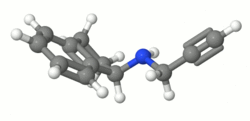Rasagiline
 |
|
 |
|
| Clinical data | |
|---|---|
| Trade names | Azilect |
| AHFS/Drugs.com | Monograph |
| MedlinePlus | a606017 |
| License data |
|
| Pregnancy category |
|
| Routes of administration |
Oral |
| ATC code | N04BD02 (WHO) |
| Legal status | |
| Legal status | |
| Pharmacokinetic data | |
| Bioavailability | 36% |
| Protein binding | 88 – 94% |
| Metabolism | Hepatic (CYP1A2-mediated) |
| Biological half-life | 3 hours[citation needed] |
| Excretion | Renal and fecal |
| Identifiers | |
|
|
| CAS Number | 136236-51-6 |
| PubChem (CID) | 3052776 |
| IUPHAR/BPS | 6641 |
| DrugBank | DB01367 |
| ChemSpider | 2314553 |
| UNII | 003N66TS6T |
| KEGG | D02562 |
| ChEMBL | CHEMBL887 |
| PDB ligand ID | RAS (PDBe, RCSB PDB) |
| Chemical and physical data | |
| Formula | C12H13N |
| Molar mass | 171.238 g/mol |
| 3D model (Jmol) | Interactive image |
|
|
|
|
| |
|
Rasagiline (Azilect, TVP-1012, N-propargyl-1(R)-aminoindan[1]) is an irreversible inhibitor of monoamine oxidase-B[2] used as a monotherapy to treat symptoms in early Parkinson's disease or as an adjunct therapy in more advanced cases.[3]
The racemic form of the drug was invented by Aspro Nicholas in the early 1979s. Moussa B.H. Youdim identified it as a potential drug for Parkinson's disease, and working with collaborators at Technion – Israel Institute of Technology in Israel and the drug company, Teva Pharmaceutical, identified the R-isomer as the active form of the drug.[4] Teva brought it to market in partnership with Lundbeck in Europe and Eisai in the US and elsewhere. It was approved in Europe in 2005 and in the US in 2006.
Contents
Medical use[edit]
Rasagiline is used to treat symptoms of Parkinson's disease both alone and in combination with other drugs. It has shown efficacy in both early and advanced Parkinsons, and appears to be especially useful in dealing with non-motor symptoms like fatigue.[5][6][7]
Rasagiline has not been tested in pregnant women and is Pregnancy Category C in the US.[7]
Side effects[edit]
The FDA label contains warnings that rasagiline may cause severe hypertension or hypotension, may make people sleepy, may make motor control worse in some people, may cause hallucinations and psychotic-like behavior, may cause impulse control disorder, may increase the risk of melanoma, and upon withdrawal may cause high fever or confusion.[7]
Side effects when the drug is taken alone include flu-like symptoms, joint pain, depression, stomach upset, headache, dizziness, and insomnia. When taken with L-DOPA, side effects include increased movement problems, accidental injury, sudden drops in blood pressure, joint pain and swelling, dry mouth, rash, abnormal dreams and digestive problems including vomiting, loss of appetite, weight loss, abdominal pain, nausea, constipation.[7] When taken with Parkinson's drugs other than L-DOPA, side effects include peripheral edema, fall, joint pain, cough, and insomnia.[7]
Interactions[edit]
People who are taking meperidine, tramadol, methadone, propoxyphene, dextromethorphan, St. John’s wort, cyclobenzaprine, or another MAO inhibitor should not take rasagiline.[7]
The FDA drug label carries a warning of the risk of serotonin syndrome when rasagiline is used with antidepressants or with meperidine.[7] However the risk appears to be low, based on a multicenter retrospective study in 1504 people, which looked for serotonin syndrome in people with PD who were treated with rasagiline plus antidepressants, rasagiline without antidepressants, or antidepressants plus Parkinson's drugs other than either rasagiline or selegiline; no cases were identified.[5]
There is a risk of psychosis or bizarre behavior if rasagiline is used with dextromethorphan and there is a risk of non-selective MAO inhibition and hypertensive crisis if rasagiline is used with other MAO inhibitors.[7]
Chemistry[edit]
Rasagiline is molecularly a propargylamine derivative.[8] The form brought to market by Teva and its partners is the mesylate salt, and was designated chemically as: 1H-Inden-1-amine-2,3-dihydro-N-2-propynyl-(1R)-methanesulfonate.[7]
Pharmacology[edit]
Mechanism of Action[edit]
Parkinson's disease is characterized by the death of cells that produce dopamine, a neurotransmitter. An enzyme called monoamine oxidase (MAO) breaks down neurotransmitters. MAO has two forms, MAO-A and MAO-B. MAO-B breaks down dopamine. Rasagiline prevents the breakdown of dopamine by irreversibly binding to MAO-B. Dopamine is therefore more available, somewhat compensating for the diminished quantities made in the brains of people with Parkinsons.[5]
Selegiline was the first selective MAO-B inhibitor. It is partly metabolized to levomethamphetamine (l-methamphetamine), one of the two enantiomers of methamphetamine, in vivo.[9][10] While these metabolites may contribute to selegiline's ability to inhibit reuptake of the neurotransmitters dopamine and norepinephrine, they have also been associated with orthostatic hypotension and hallucinations in some people.[10][11][12] Rasagiline metabolizes into 1(R)-aminoindan which has no amphetamine-like characteristics[13] and has neuroprotective properties in cells and in animal models.[14]
It is selective for MAO type B over type A by a factor of fourteen.[15]
Metabolism[edit]
Rasagiline is broken down via CYP1A2,[16] part of the cytochrome P450 metabolic path in the liver. It is contraindicated in patients with hepatic insufficiency and its use should be monitored carefully in patients taking other drugs that alter the normal effectiveness of this metabolic path.[7]
History[edit]
Racemic rasagiline was discovered and patented by Aspro Nicholas in the 1970s as a drug candidate for treatment of hypertension.[17]
Moussa Youdim, a biochemist, had been involved in developing selegiline as a drug for Parkinsons, in collaboration with Peter Reiderer. He wanted to find a similar compound that would have fewer side effects, and around 1977, at about the same time he moved from London to Haifa to join the faculty of Technion, he noticed that rasagiline could potentially be such a compound.[18] He called that compound, AGN 1135.[19]
In 1996 Youdin, in collaboration with scientists from Technion and the US National Institutes of Health, and using compounds developed with Teva Pharmaceutical, published a paper in which the authors wrote that they were inspired by the racemic nature of deprenyl and the greater activity of one of its steroisomers, L-deprenyl, which became selegiline, to explore the qualities of the isomers of the Aspro compound, and they found that the R-isomer had almost all the activity; this is the compound that became rasagiline.[19] They called the mesylate salt of the R-isomer TVP-1012 and the hydrochloride salt, TVP-101.[19]
Teva and Technion filed patent applications for this racemically pure compound, methods to make it, and methods to use it to treat Parkinsons and other disorders, and Technion eventually assigned its rights to Teva.[20]
Teva began development of rasagiline, and by 1999 was in Phase III trials, and entered into a partnership with Lundbeck in which Lundbeck agreed to share the costs and obtained the joint right to market the drug in Europe.[21] In 2003 Teva partnered with Eisai, giving Eisai the right to jointly market the drug for Parkinson's in the US, and to co-develop and co-market the drug for Alzheimers and other neurological diseases.[22]
It was approved by the European Medicines Agency for Parkinson's in 2005[14] and in the US in 2006.[8]:255
Research[edit]
Rasagiline was tested for efficacy in people with multiple system atrophy in a large randomized, placebo-controlled, double-blind disease-modification trial; the drug failed.[23]
Teva conducted clinical trials attempting to prove that rasagiline did not just treat symptoms, but was a disease-modifying drug - that it actually prevented the death of the dopaminergic neurons that characterize Parkinson's disease and slowed disease progression. They conducted two clinical trials, called TEMPO and ADAGIO, to try to prove this. The FDA advisory committee rejected their claim in 2011, saying that the clinical trial results did not prove that rasagiline was neuroprotective. The main reason was that in one of the trials, the lower dose was effective at slowing progression, but the higher dose was not, and this made no sense in light of standard dose-response pharmacology.[24][25]
See also[edit]
References[edit]
- ^ Akao Y, et al. An anti-Parkinson's disease drug, N-propargyl-1(R)-aminoindan (rasagiline), enhances expression of anti-apoptotic bcl-2 in human dopaminergic SH-SY5Y cells. Neurosci Lett. 2002 Jun 28;326(2):105-8. PMID 12057839
- ^ Oldfield V, Keating GM, Perry CM (2007). "Rasagiline: a review of its use in the management of Parkinson's disease". Drugs. 67 (12): 1725–47. doi:10.2165/00003495-200767120-00006. PMID 17683172.
- ^ Gallagher DA, Schrag A (2008). "Impact of newer pharmacological treatments on quality of life in patients with Parkinson's disease". CNS Drugs. 22 (7): 563–86. doi:10.2165/00023210-200822070-00003. PMID 18547126.
- ^ Lakhan SE (2007). "From a Parkinson's disease expert: Rasagiline and the Future of Therapy" (PDF). Molecular Neurodegeneration. 2 (1): 13–5. doi:10.1186/1750-1326-2-13. PMC 1929084
 . PMID 17617893.
. PMID 17617893. - ^ a b c Stocchi F, Fossati C1 Torti M. Rasagiline for the treatment of Parkinson's disease: an update. Expert Opin Pharmacother. 2015;16(14):2231-41. PMID 26364897
- ^ Elbers RG et al. Interventions for fatigue in Parkinson's disease. Cochrane Database Syst Rev. 2015 Oct 8;10:CD010925. PMID 26227071
- ^ a b c d e f g h i j Azilect Prescribing Information Label last revised May, 2014
- ^ a b Richard B. Silverman, Mark W. Holladay. The Organic Chemistry of Drug Design and Drug Action, 3rd Edition. Academic Press, 2014 ISBN 9780123820310
- ^ Engberg, G; Elebring, T; Nissbrandt, H (1991). "Deprenyl (selegiline), a selective MAO-B inhibitor with active metabolites; effects on locomotor activity, dopaminergic neurotransmission and firing rate of nigral dopamine neurons". The Journal of Pharmacology and Experimental Therapeutics. 259 (2): 841–7. PMID 1658311.
- ^ a b Lemke, Thomas L.; Williams, David A, eds. (2012). Foye's Principles of Medicinal Chemistry. Lippincott Williams & Wilkins. p. 434. ISBN 1609133455.
- ^ Bar Am, Orit; Amit, Tamar; Youdim, Moussa B. H. (2004-01-30). "Contrasting neuroprotective and neurotoxic actions of respective metabolites of anti-Parkinson drugs rasagiline and selegiline". Neuroscience Letters. 355 (3): 169–172. doi:10.1016/j.neulet.2003.10.067. ISSN 0304-3940. PMID 14732458.
- ^ Yasar, S.; Goldberg, J. P.; Goldberg, S. R. (1996-01-01). "Are metabolites of l-deprenyl (selegiline) useful or harmful? Indications from preclinical research". Journal of Neural Transmission. Supplementum. 48: 61–73. ISSN 0303-6995. PMID 8988462.
- ^ Chen JJ, Swope DM (2005). "Clinical pharmacology of rasagiline: a novel, second-generation propargylamine for the treatment of Parkinson disease". J Clin Pharmacol. 45 (8): 878–94. doi:10.1177/0091270005277935. PMID 16027398.
- ^ a b Schapira A, Bate G, Kirkpatrick P. Fresh from the Peiple: Rasagiline. Nat Rev Drug Discov. 2005 Aug;4(8):625-6. PMID 16106586
- ^ Binda C, Hubálek F, Li M, Herzig Y, Sterling J, Edmondson DE, Mattevi A (2005). "Binding of Rasagiline-related Inhibitors to Human Monoamine Oxidases: A Kinetic and Crystallographic Analysis". Journal of Medicinal Chemistry. 48 (26): 8148–54. doi:10.1021/jm0506266. PMC 2519603
 . PMID 16366596.
. PMID 16366596. - ^ Lecht S, Haroutiunian S, Hoffman A, Lazarovici P (2007). "Rasagiline – a novel MAO B inhibitor in Parkinson's disease therapy". Ther Clin Risk Manag. 3 (3): 467–74. PMC 2386362
 . PMID 18488080.
. PMID 18488080. - ^ US 3,513,244. See US patent 5453446, lines 50-60. US Patent 5453446 was the patent at issue in Teva v Watson, see page 2
- ^ Judy Sielg-Itzkovich for the Jerusalem Post. November 13, 2010. Making armor for the brain
- ^ a b c Finberg JP, Lamensdorf I, Commissiong JW, Youdim MB. Pharmacology and neuroprotective properties of rasagiline. Pharmacology and neuroprotective properties of rasagiline. J Neural Transm Suppl. 1996;48:95-101. PMID 8988465
- ^ Teva v Watson, see page 2
- ^ Kupsch A Rasagiline. Teva Pharmaceutical. Curr Opin Investig Drugs. 2002 May;3(5):794-7. PMID 12090555
- ^ Eisai Press Release. May 15, 2003
- ^ Poewe W, Mahlknecht P, Krismer F Therapeutic advances in multiple system atrophy and progressive supranuclear palsy. Mov Disord. 2015 Sep 15;30(11):1528-38. PMID 26227071
- ^ Vadim Sviderski for Reuters and Haaretz. Oct 19, 2011 FDA Advisers Refuse Teva Plea to Expand Azilect Label
- ^ Russel Katz, M.D.; et al. "Peripheral and Central Nervous System Advisory Committee Background Package on Azilect" (PDF). FDA. Retrieved December 7, 2011.